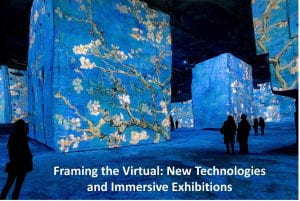Framing the Virtual: New Technologies and Immersive Exhibitions, Emily Lawhead and Kate Mondloch, eds., special issue of Arts, 2023
Immersive exhibitions have a long history in modern and contemporary art. The metaphor of immersion implies a plunge into an all-encompassing environment, where audiences are seemingly transported into alternate, virtual realities. From panoramas and 3D cinemas to site-specific installations and performances, a wide variety of mediums, practices, and sites have framed immersive experiences in exhibition contexts. Emerging technologies have also played a significant role in this history, as the capabilities of carousel slide projectors, IMAX screens, digital projection mapping, and virtual and augmented reality assist in the transformation of “real” space into “virtual” space.
This Special Issue of Arts considers the role of new technologies in facilitating immersive art exhibitions. How do histories of technology intersect with histories of immersion and the virtual? How do new technologies influence artistic practices such as installation art, performance, or exhibition design? How does technology—broadly defined—impact how audiences experience and interact with exhibition spaces?
“Framing the Virtual: New Technologies and Immersive Exhibitions” welcomes contemporary and historical analyses of immersive technologies and exhibition practices. Potential topics may include: the recent proliferation of immersive, interactive, and experimental art spaces such as Superblue, Artechouse, Meow Wolf, teamLab, and Immersive van Gogh/Klimt/Kahlo; media archaeologies of immersive technology in art; virtual, augmented, and mixed reality in artistic practice; exhibition design intended to envelop audiences in other worlds; and reflections of immersive experience in design, the performing arts, land/environmental art, architecture, and other site-based practices.
